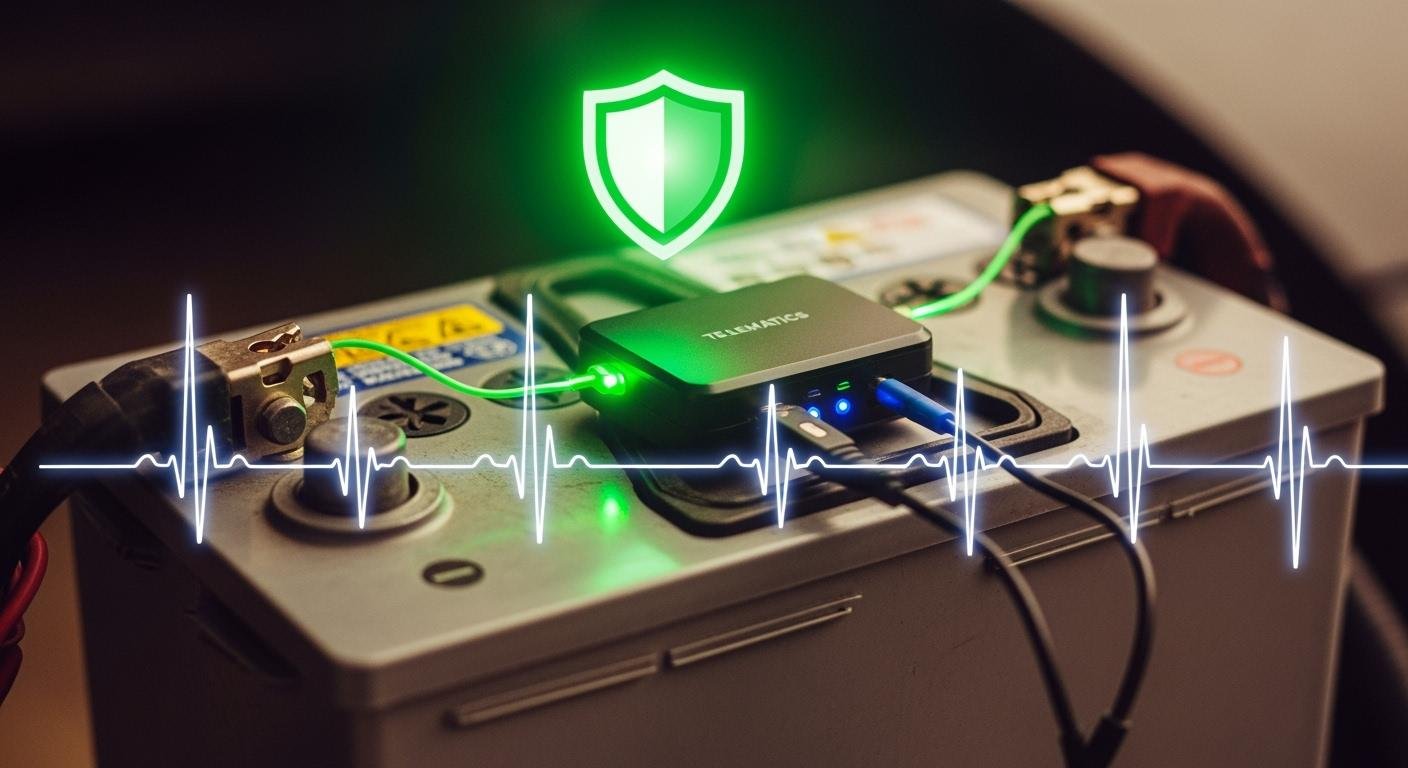
Drivers can prevent telematics-related battery failure. Success depends on correct installation, smart device selection, and consistent vehicle usage. Telematics devices require a small, constant power supply from the vehicle battery. This creates a minor, continuous drain. Managing this power draw is essential for maintaining good battery health. The right solutions ensure the telematics system never causes a dead battery.
请注意: A healthy battery is the foundation. Understanding the small drain from telematics is the first step toward preventing battery drain issues.
How Telematics Systems Impact Battery Life

A telematics system connects to the vehicle’s battery for power. This connection allows the device to function even when the engine is off. Understanding how these devices use power is key to preventing battery drain. The constant, small drain is normal, but certain factors can increase it.
Normal Power Draw in Sleep Mode
Modern telematics devices are designed for efficiency. They enter a “sleep mode” when the vehicle is parked. In this state, the power drain is extremely low. The device only draws enough current to stay connected and wake up when needed. A healthy battery can easily support this minimal load for weeks.
| 电压 | Sleep Mode Current Draw (mA) |
|---|---|
| 12 V | 4.5 |
| 24 V | 3.0 |
Key Factors That Increase Drain
The power drain from a telematics device increases when it is active. Several factors can cause a device to “wake up” and use more battery power.
- Frequent GPS Polling: A system set to update its location every few seconds will use more energy than one updating every few minutes.
- Continuous Data Transmission: Actively sending data over a cellular network requires significant power. This constant connection can increase the drain from around 12 mA to 130 mA.
The Risk of Faulty Installation
Improper installation is a leading cause of excessive battery drain. A poorly wired device might not enter sleep mode correctly. This causes a continuous high-power drain that can deplete a battery overnight. Sometimes, the issue is with the system itself.
A well-known example is the 2019 Subaru Starlink system. A defect in its communications module caused it to constantly search for a network, leading to widespread battery failure. This shows how a flawed system can create a persistent drain.
The Effect of Extreme Temperatures
Temperature greatly affects battery performance. In extreme cold, the chemical reactions inside a battery slow down, reducing its power output. This makes the battery work harder to supply the same amount of energy. In extreme heat, a battery’s self-discharge rate increases. The general rule is that for every 10°C (18°F) rise in temperature, the self-discharge rate doubles. This accelerated drain makes the battery more vulnerable to failure, especially in an idle vehicle.
Proactive Telematics Battery Solutions
Fleet managers and drivers can take active steps to prevent battery issues. These proactive solutions focus on proper setup, regular maintenance, and smart technology choices. Following these practices ensures the telematics system works without compromising the vehicle battery.
Ensure Professional Installation
Correct installation is the most critical step to prevent battery drain. A professional installer possesses the right skills and knowledge. They ensure the telematics device connects to the vehicle’s electrical system correctly.
Technicians often hold specific certifications that prove their expertise.
- MECP Certification: The Mobile Electronics Certified Professional (MECP) program offers an Apprentice and a Skilled Installation Technician certification. These credentials show a technician understands complex vehicle electronics.
- Industry Confirmations: Many automotive trade schools offer certificate programs. Industry partners recognize these programs, confirming a technician’s qualifications for installing telematics devices.
A key professional technique is using an ignition-sensing installation. This method connects the device to a circuit that is only active when the engine is on. It prevents the device from drawing power when the vehicle is parked. This technique can reduce idle drain to less than 5 mA, virtually eliminating the risk of a dead battery from the device.
Maintain a Consistent Driving Schedule
A vehicle’s alternator recharges the battery while the engine is running. Infrequent driving prevents the battery from fully recharging. This is especially true for vehicles with a constant small power drain from a telematics unit.
To maintain a good state of charge, a driver should operate the vehicle for at least 30-45 minutes every 10 to 14 days. This allows the alternator enough time to replenish the energy used by the telematics device and the battery’s natural self-discharge.
Conduct Regular Battery Health Checks
Regularly checking the battery health is a vital part of preventative maintenance. Experts recommend a professional battery inspection at least twice a year, or every 6,000 miles. These checks can identify a weakening battery before it fails. A technician will measure key performance metrics.
- Cold Cranking Amps (CCA): This shows the battery’s ability to start an engine in cold weather.
- Reserve Capacity: This indicates how long the battery can power essential systems if the alternator fails.
Monitoring battery health helps you understand its condition and decide when a replacement is necessary. This simple step avoids an unexpected battery failure.
Choose Devices with Low-Power Modes
Modern telematics devices come with advanced power-saving features. Fleet managers should choose devices with configurable low-power or “sleep” modes. These modes significantly reduce energy consumption when the vehicle is not in use. For example, some Teltonika models like the FMC920, FTC921和 FMB120 offer multiple sleep settings. These include Deep Sleep and Ultra Deep Sleep modes, where the device turns off its GPS and cellular modems to save maximum power.
The difference in power consumption is significant. Low-power modes can reduce energy use by over 99% compared to normal standby.
| Mode | Power Consumption (μA) |
|---|---|
| DRX (normal standby) | 1300 |
| eDRX (extended standby) | 47.5 |
| PSM (low-power) | 4 – 8 |

Use Health Monitoring Features
Some of the best solutions involve using the telematics system itself. Advanced telematics platforms offer real-time monitoring of the vehicle’s battery. These systems track the battery’s voltage and state of charge. This capability for monitoring battery health turns the device into a protective tool.
For instance, a battery management system like the Midtronics BMS-300 measures the battery during every start event. It sends this data to the telematics platform. Similarly, systems from ChargePoint 和 Stafl Systems provide powerful insights by leveraging real-time data. If the voltage drops below a safe threshold, the system can send automatic battery notifications. These alerts give managers a chance to address the issue before it leads to downtime. These notifications are a key feature for proactive fleet management.
Troubleshooting and Diagnosing Battery Failure

When a vehicle battery fails, quick diagnostics can save time and money. Identifying the root cause, whether it is the telematics system or another component, is the first step toward a solution.
Early Warning Signs of Drain
Drivers can spot early signs of excessive battery drain. Common symptoms include slow engine cranking and dimming headlights. These signs suggest a problem that needs attention before it causes a complete battery failure. A clicking sound when trying to start the engine or a swollen battery case also points to a failing battery. These warnings indicate that the battery’s performance is declining.
Performing a Basic Voltage Test
A basic voltage test provides a clear picture of battery health. A driver can perform this test with a digital multimeter.
- Set the multimeter to DC volts (VDC).
- Touch the red probe to the positive (+) battery terminal and the black probe to the negative (-) terminal.
- A healthy, fully charged battery should read around 12.6 volts. A reading below 12.2 volts indicates a low state of charge.
This simple battery diagnostic check helps determine if the battery is holding a proper charge.
Isolating the Problem’s Source
If the battery is losing its charge, the next step is to find the source of the drain. A parasitic draw test can isolate the faulty circuit. This involves connecting a multimeter in series with the negative battery cable to measure the current draw when the vehicle is off. A normal draw is under 50 milliamps. If the reading is higher, removing fuses one by one can identify the circuit causing the issue. To check the telematics device, a technician can measure the vehicle’s power draw with the device connected and then disconnected. This helps confirm if the telematics unit is the source of the drain.
When to Contact Support
If the telematics device is the suspected cause, the user should contact the provider’s support team. Before calling, it is helpful to gather information. This includes any fault codes from the system, the vehicle’s battery voltage readings, and details about device behavior. Providing specific data, such as frequent device restarts or high upload failures, helps the support agent with their diagnostics. This preparation ensures vehicle issues diagnosed by the system are addressed efficiently.
What to Tell Your Mechanic
When visiting a mechanic, clear communication is key. The owner should describe the symptoms, such as the battery dying after being parked for a few days. It is useful to mention that the drain may be linked to the telematics unit, and provide the fuse number if it has been identified. This information helps the mechanic troubleshoot the problem faster, leading to better vehicle performance and maintenance. A good description helps get vehicle issues diagnosed correctly.
Telematics are valuable tools for any vehicle. Users can prevent battery drain by following simple, proactive steps. These actions protect the vehicle battery and ensure the telematics system functions correctly. Following this guidance eliminates the risk of battery failure.
Key prevention tactics include:
- Ensuring professional installation to prevent excess drain.
- Maintaining a regular driving schedule to keep the battery charged.
- Performing periodic checks to monitor battery health.
These practices empower drivers to manage their vehicle’s battery health. A healthy battery supports the telematics device, allowing users to enjoy its full benefits without worry.
常见问题
Can a telematics device drain a new battery?
Yes, any telematics device can drain a new vehicle battery. Improper installation or a faulty device can cause a significant power draw. This continuous drain will deplete even a healthy new battery over time if the vehicle is not driven regularly.
How long can a car sit with a telematics device?
A vehicle with a properly installed telematics device can typically sit for two to three weeks. The device’s low-power sleep mode draws minimal current. A healthy battery can easily handle this small load without losing its state of charge.
Does turning off the telematics device stop battery drain?
Turning off the device can help, but it may not stop all drain. Some units still draw a small amount of power to maintain settings. The best solution is professional installation that connects the device to an ignition-switched circuit, preventing any drain when the car is off.
What is the fastest way to check for battery drain?
A quick voltage test is the fastest method. A multimeter can measure the battery voltage. A reading below 12.2 volts on a resting battery suggests a significant drain or a failing battery. Advanced telematics systems also offer real-time battery monitoring features.

